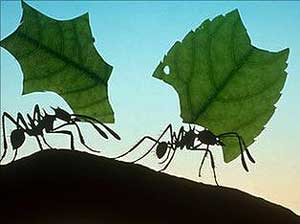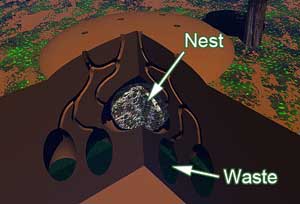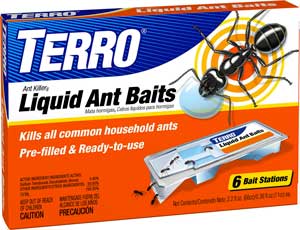What organism can support 100 times its own weight, stand upside-down on glass, is found on every continent except for Antarctica and is the most efficient predator on earth? Why it is none other than the world’s smallest gardener, the ant. These social insects are virtually helpless by themselves, but in a colony they can be a thing feared by animals and humans alike.
In fact, next to humans, ants form the largest and most complex animal societies on Earth.
One Species…the Leaf Cutter Ant
 I was first introduced to these marvelous creatures when I studied abroad in Costa Rica. While trekking through the jungle I came across my first colony of these ants. I was mesmerized by the colors of the leaves carried on the workers’ backs (reds, oranges and greens), the amazing self-organization, and just sheer numbers of the colony in action. If I haven’t grabbed you yet, let us dig a bit deeper into their hierarchical caste system, waste management, and impact on the forest.
I was first introduced to these marvelous creatures when I studied abroad in Costa Rica. While trekking through the jungle I came across my first colony of these ants. I was mesmerized by the colors of the leaves carried on the workers’ backs (reds, oranges and greens), the amazing self-organization, and just sheer numbers of the colony in action. If I haven’t grabbed you yet, let us dig a bit deeper into their hierarchical caste system, waste management, and impact on the forest.
Hierarchial Caste System
In a colony of five to ten million workers how does each ant know what to do? It has to do with their highly evolved caste system. The labor is divided into three main castes (queen, workers, and drones) based on the size, shape, and sex of the individual ant. Each caste is specifically designed for specialized tasks.
- The queen ant is the only reproductive female in the colony and the largest member. Her sole responsibility is to lay eggs. She can lay over 50 million eggs in her lifetime. Ouch!

A male leaf cutter ant
- Next are the workers that can be split into multiple sub castes based on their size. However, lets stick with the two main sub castes, which are soldiers and foragers. The soldiers are much larger with oversized heads and mandibles. They defend the colony against predators. Their mandibles are strong enough to cut through leather, so make sure not to get too close! Foragers, on the other hand, are smaller. Their heads are the optimal size to remove leaves from trees and plants. Once they have collected the necessary plant material they return to the nest. Fun fact: all of the workers in a colony are sterile female ants.
- Last, but not least, are the drones or male individuals of the colony. These winged ants, yes I said winged, are only created when it is time to start a new colony. Their sole purpose is to mate with the new queen. After mating is complete all of the males die. A single male does not live for more than 3 days. Poor fellow.
Waste Management
Just like humans, these ants create LOTS, I mean LOTS, of waste. Where does all of this waste come from? Well the ants do not actually eat the leaves that they carry back to the nest (they cannot digest the plant material). Instead they have a mutualistic relationship with a fungus that lives inside of their nest. They feed the fungus chewed up plant material and the fungus acts as a food source for the ants. Pretty crazy, huh? This means the ants are actually farmers.
 Since they accumulate so much waste while caring for the fungus, these ants have developed one of the most sophisticated waste management systems here on Earth. Waste exposure increases the risk of diseases and parasites that can threaten the entire colony. However, ants are pretty darn smart. They have two lines of defense to prevent the build up and contamination of waste. The first is the segregation of waste from the colony. These sites are known as “dumps.” Pretty similar to humans, right?
Since they accumulate so much waste while caring for the fungus, these ants have developed one of the most sophisticated waste management systems here on Earth. Waste exposure increases the risk of diseases and parasites that can threaten the entire colony. However, ants are pretty darn smart. They have two lines of defense to prevent the build up and contamination of waste. The first is the segregation of waste from the colony. These sites are known as “dumps.” Pretty similar to humans, right?
The second line of defense is the “waste transporters and heap workers.” These workers are specialized to work with the waste. If the heap workers venture too far from the dump other ants kill them because the colony cannot be exposed to potential contamination. Oh man, that is harsh!
Impact on the Forest
 Leaf cutter ants have been designated as key species and ecosystem engineers. They disperse plant seeds, aerate the soil during nest construction, and remove leaf litter, which allows young seedlings to grow in the newly cleared area. Also, they are strategic when cutting leaves. They do not want to kill the trees once their leaves are removed. Instead, they rotate the trees they harvest. Their constant leaf removal allows for more sunlight to reach the forest floor. This sounds awfully similar to many of our own environmentally sound plant harvesting strategies.
Leaf cutter ants have been designated as key species and ecosystem engineers. They disperse plant seeds, aerate the soil during nest construction, and remove leaf litter, which allows young seedlings to grow in the newly cleared area. Also, they are strategic when cutting leaves. They do not want to kill the trees once their leaves are removed. Instead, they rotate the trees they harvest. Their constant leaf removal allows for more sunlight to reach the forest floor. This sounds awfully similar to many of our own environmentally sound plant harvesting strategies.
In Conclusion
 So how does this affect our lives here in California? Although ants can spoil our picnics or become unwelcome visitors inside of our homes, we should look a little deeper and see that most ants are actually beneficial in our lives. They turn more soil than earthworms, aid in decomposition, disperse the seeds of many plants, and also kill many pest species. To some people in Costa Rica, leaf cutter ants are the pests, however, they play an important role in forest regeneration, soil aeration, and nutrient cycling. The nonstop work of these social insects is mesmerizing and they are models of efficiency.
So how does this affect our lives here in California? Although ants can spoil our picnics or become unwelcome visitors inside of our homes, we should look a little deeper and see that most ants are actually beneficial in our lives. They turn more soil than earthworms, aid in decomposition, disperse the seeds of many plants, and also kill many pest species. To some people in Costa Rica, leaf cutter ants are the pests, however, they play an important role in forest regeneration, soil aeration, and nutrient cycling. The nonstop work of these social insects is mesmerizing and they are models of efficiency.
For more information about the fascinating world of ants please watch this clip from National Geographic. It was written and recorded by award-winning cameraman Wolfgang Thaler and Bert Hoelldobler. It was my inspiration for this blog and captures the captivating lives of a number of ant species.
https://www.youtube.com/watch?v=Z-gIx7LXcQM
At High Trails Outdoor Science School, we literally force our instructors to write about elementary outdoor education, teaching outside, learning outside, our dirty classroom (the forest…gosh), environmental science, outdoor science, and all other tree hugging student and kid loving things that keep us engaged, passionate, driven, loving our job, digging our life, and spreading the word to anyone whose attention we can hold for long enough to actually make it through reading this entire sentence. Whew…. www.dirtyclassroom.com


Comments are closed.